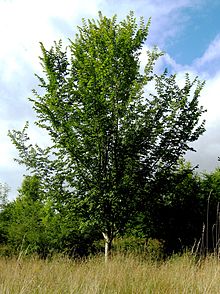Ulmus 'Nanguen'
| Ulmus hybrid cultivar | |
|---|---|

Lutèce aged 12 years, Great Fontley, UK
|
|
| Hybrid parentage | 'Plantyn' × ('Bea Schwarz' × 'Bea Schwarz' selfed) |
| Cultivar | 'Nanguen' = Lutece™ |
| Origin | Wageningen, The Netherlands |
Ulmus 'Nanguen' (selling name Lutèce) is a complex fourth generation hybrid cultivar from the cross 'Plantyn' × ('Bea Schwarz' selfed), an ancestry comprising four field elms (U. minor), a wych elm (U. glabra), the curious Exeter Elm ('Exoniensis'), and a frost-resistant selection of the Himalayan elm (U. wallichiana).
Originally identified as clone 812, Lutèce was not promoted by the Dutch owing to unfounded fears that it may prove susceptible to coral spot fungus (Nectria cinnabarina). Instead, '812' was acquired by the French Institut National de la Recherche Agronomique (INRA), which subjected the tree to 20 years of field trials in the Bois de Vincennes, Paris, before patenting and release in 2002 as 'Nanguen' = Lutèce.
Lutèce was introduced to the UK by the Hampshire & Isle of Wight Branch, Butterfly Conservation, in 2002, as part of its assessment of DED-resistant cultivars as potential hosts of the endangered White-letter Hairstreak.
The stem of Lutèce typically forks at a height of 1–2 m, where 3–5 steeply ascending branches develop in conjunction with more obtusely angled lower side branches to form an amorphous open crown. The ultimate size and shape of this cultivar remains unknown but, given its ancestry, it should reach at least 30 m in height. The trees planted in the Bois de Vincennes attained an average height of 12.5 m with a trunk diameter of 22 cm at 20 years of age. Quick growing on moist, well-drained soils, increasing in height by an average of 80 cm per annum, the tree commences flowering in late March when aged seven years. The leaves are elliptic to orbicular < 11 cm long × 9 cm wide, the acuminate apex far less pronounced than in most other elms, with coarse, doubly serrate margins; the upper surface is rough. The leaves flush relatively late, rarely before mid-May in England. The samarae are obovate, slightly notched at the outer end, 14–22 mm long by 11–17 mm broad. The seed is not central but slightly nearer the notch, and ripens in late May. The tree commonly suckers from the roots.
...
Wikipedia
